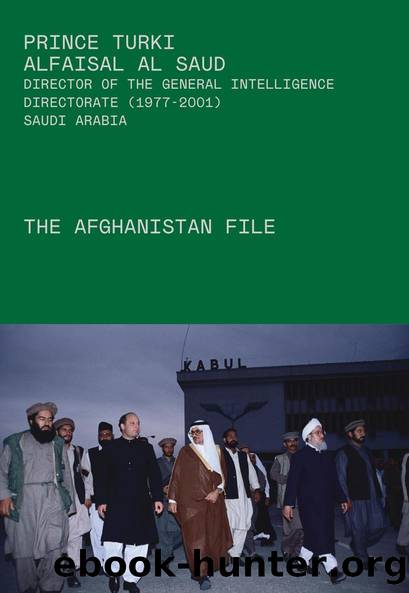The Afghanistan File by Prince Turki AlFaisal Al Saud

Author:Prince Turki AlFaisal Al Saud
Language: eng
Format: epub
ISBN: 978-1-911487-57-9
Publisher: Arabian Publishing
Published: 2021-08-16T00:00:00+00:00
Chapter 9
The Loya Jirga at Rawalpindi
Much changed in 1989, the year of the Soviet withdrawal. Up to this point, the three foreign partners backing the Mujahideen had generally worked rather well together. We had all wanted to push the Russians out of Afghanistan and remove the Communist regime. And the personalities involved had been more or less the same â President Reagan, William Casey and then Robert Gates at the CIA, President Zia and General Akhtar Abdul Rahman Khan, King Fahd and myself. Now our interests diverged â not completely, but it became clear that we had different emphases and in the United States and Pakistan there were new leaders.
The United States had always been most interested in defeating the Soviet Union and weakening it internally â as well as getting its revenge for Vietnam. Once these things happened it saw its mission as being accomplished. Of course, there were differences among various departments. The CIA officials seemed most interested in finishing the war and removing Najibullah; the State Department at this time seemed more worried by the increasing strength of Hekmatyar and the more militant Islamists. At the top of the US administration President George H.W. Bush, who took office in January 1989, was never greatly interested in Afghanistan. For him it was a matter of waning importance â something successfully resolved under his predecessor â and he faced more important and exciting issues, notably the collapse of Communism in Eastern Europe that year and the prospect of a reunited Germany. There was a big cut â more than half â in the money the CIA was allocated for Afghanistan in the fiscal year from October 1989 to October 1990.
Pakistan remained hugely involved with Afghanistan. It still had a hostile neighbour in the Najibullah regime, so it very much wanted the Mujahideen to take Kabul. It also wanted the three million Afghan refugees it had on its soil to go home, and soon. As the Soviet Central Asian republics became independent in the later months of 1991, Pakistan became interested in opening a trade route to them through Afghanistan. It had a new Prime Minister in Benazir Bhutto, the daughter of Zulfikar Ali Bhutto. She had come to power after the army, shocked by the death of President Zia, had agreed to the return of democratic politics. Benazir was young â she was thirty-six â Western-educated, with no experience of government, and was very distrustful of the army and particularly the ISI. It was the army, after all, which had killed her father. In her government one could see some marked tensions in policy towards Afghanistan. The ISI and much of the military establishment remained strongly in support of Hekmatyar, Islamist militancy and the Pathan elements in Afghanistan. Benazir herself was more inclined to coordinate her actions with whatever remained of American policy.
In Saudi Arabia there were no changes at the top of the government and we had no reason to change our policies. Our mission had been partly
Download
This site does not store any files on its server. We only index and link to content provided by other sites. Please contact the content providers to delete copyright contents if any and email us, we'll remove relevant links or contents immediately.
| Africa | Americas |
| Arctic & Antarctica | Asia |
| Australia & Oceania | Europe |
| Middle East | Russia |
| United States | World |
| Ancient Civilizations | Military |
| Historical Study & Educational Resources |
The Battle of Mogadishu by Matt Eversmann & Dan Schilling(610)
The Confidence Men by Margalit Fox(534)
The Spymaster of Baghdad by Margaret Coker(531)
A History of the Muslim World since 1260: The Making of a Global Community by Vernon O. Egger(515)
Jack the Ripper and the East End by Peter Ackroyd(471)
Empire of Fear: Inside the Islamic State by Andrew Hosken(464)
Islam At The Gates: How Christendom Defeated the Ottoman Turks by Diane Moczar(460)
The Crimean War by Winfried Baumgart(460)
The Jerusalem Diamond by Noah Gordon(454)
The Afghanistan File by Prince Turki AlFaisal Al Saud(454)
A Concise History of Greece (Cambridge Concise Histories) by Richard Clogg(441)
Akhenaten by Dominic Montserrat(441)
Israel: Ancient Kingdom or Late Invention? by Daniel I. Block(437)
The History of Jihad by Robert Spencer(430)
Enemy in the East by Rolf-Dieter Müller(427)
The Privatization of Israeli Security by Shir Hever(425)
Destroying a Nation: The Civil War in Syria by Nikolaos van Dam(422)
The Nine Lives of Pakistan by Declan WALSH(414)
The Dirty War in Kashmir by Shujaat Bukhari(403)
